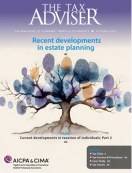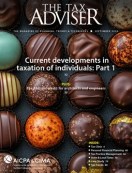- tax clinic
- corporations & shareholders
Sec. 382 and exceptions to the segregation rules
Related
R&D tax credits: A new era of disclosure and documentation
IRS renews corporate tax opportunities with letter rulings
Commonly overlooked business property tax compliance and valuation issues
Editor: Jessica L. Jeane, J.D.
Sec. 382 limits a loss corporation that undergoes an ownership change from utilizing pre–change losses or other tax attributes to offset post–change income or tax liability. An ownership change occurs when, immediately following an owner shift or equity structure shift, the percentage by value of a loss corporation owned by one or more 5% shareholders increases by more than 50 percentage points over the lowest percentage ownership of such shareholders in a three–year period (Sec. 382(g)). If an ownership change occurs, then the pre–change tax attributes of the loss corporation, including net operating losses, carryovers of capital losses or disallowed interest, or tax credits, may be limited in their use during the post–change period. The calculation of the Sec. 382 limitation is complex but generally is most influenced by the value of the company on the ownership change date and the corporation’s inside tax basis in its assets.
A 5% shareholder is defined as an individual who owns a 5% or more interest in the stock of the corporation at any time during the testing period (Sec. 382(k)(7)). The testing period is generally the three–year period ending on the day of such a change (Sec. 382(i)). This ownership can be direct or indirect through another entity, referred to as a first–tier or higher–tier entity. All stock owned by shareholders of a corporation who are not 5% shareholders is treated as stock owned by one 5% shareholder. This aggregation of less–than–5% shareholders is referred to as a “public group.” The aggregation rules are provided for administrative convenience for the taxpayer by allowing the aggregation of these smaller shareholders into one group and avoiding the need to track each small shareholder.
When certain transactions occur, as identified in Secs. 382(g)(4)(B) and (C), the statutes and regulations call for the segregation of shareholders into multiple public groups that are tracked separately from each other. Each public group is deemed to be a 5% shareholder for the purpose of determining whether an ownership change has occurred. Segregation transactions include, but are not limited to, issuances, transfers, and redemptions of stock in the loss corporation. Complex rules regarding the aggregation and segregation of public groups among first–tier and higher–tier entities are outside the scope of this item.
Several exceptions to the segregation rules can be beneficial to the corporation in the shift percentage calculations. The most widely used are the small–issuance exception and the cash–issuance exception, which have been effective since 1992, as well as the secondary–transfer exception and the small–redemption exception, which were added by regulations promulgated in 2013. All exceptions are based on a presumption that these issuances, transfers, or redemptions will be acquired or redeemed by shareholders that are already part of the public groups, up to a certain threshold.
Small-issuance exception
The small–issuance exception applies when an issuance does not exceed the small–issuance limitation. All stock issued is considered, including stock issued to 5% shareholders, in determining whether the small–issuance limitation has been exceeded. Additionally, the small–issuance limitation is determined over the entire tax year and tracked cumulatively, decreasing each time an issuance during the year qualifies as a small issuance. Therefore, it is necessary to keep track of the balance of the small–issuance limitation throughout the year to determine if any subsequent issuance qualifies. If an issuance exceeds the small–issuance limitation on its own, not taking into account previous small issuances, then the entire issuance will not qualify. If the issuance, combined with other small issuances, causes the small–issuance exception to be exceeded for the year, then only the excess of the last issuance will not qualify for the exception.
The limitation amount can be determined using one of two alternative calculations (Regs. Sec. 1.382–3(j)(2)(iii)). One is the class–by–class method, where the limitation is 10% of the number of shares of the class at the beginning of the corporation’s tax year. The other is a corporationwide measurement, where the small–issuance limitation is 10% of the total value of the corporation at the beginning of the tax year. Once a method has been selected for a tax year, it must continue to be used for the remainder of the tax year. If more than one class of stock has been issued in a single issuance or in two or more issuances treated as a single issuance, then the corporationwide valuation method must be used.
If the small–issuance exception applies, then any stock issued to a non–5% shareholder is allocated ratably to the public groups existing immediately before the issuance, rather than being allocated to a separate public group. This can be advantageous in the shift calculation, as it will alleviate a change being caused solely by an issuance to many small shareholders due to the creation of a new public group, as opposed to aggregating with existing public groups.
According to Regs. Sec. 1.382–3(j)(8), if multiple small issuances, in the aggregate, would not be considered a small issuance and a principal purpose of issuing stock on different dates over a short period was to qualify for the small–issuance exception, then such issuances are treated as a single issuance and thus may not be subject to the small–issuance exception.
Cash-issuance exception
Another exception to the segregation rules that may apply when the small–issuance exception does not is the cash–issuance exception. When an issuance of stock is made solely for cash, then the segregation rules will not apply, up to an amount equal to one–half of the stock held before the issuance by direct public groups. Therefore, the corporation must determine what percentage of the stock is held by less–than–5% shareholders immediately before the issuance. Then, it can issue stock of up to 50% of that amount for cash, and the newly issued shares will not be subject to the segregation rules.
If the cash–issuance exception applies, then the shares issued to non–5% shareholders are allocated ratably to the existing public groups immediately before the issuance. Any shares that are not eligible for the cash–issuance exception because they exceed the 50% threshold will be allocated to a new public group.
Later acquisitions
Another rule of convenience relates to later acquisitions of stock by 5% shareholders from the public groups. When non–5% shareholders sell or transfer shares to a 5% shareholder, the transferred shares are treated as coming from the existing public groups pro rata (Temp. Regs. Sec. 1.382–2T(j)(2)(vi)).
Other exceptions to the segregation rules
Regulations issued in 2013 promulgated three additional exceptions to the segregation rules. These exceptions generally only apply to transactions occurring after Oct. 22, 2013 (T.D. 9638).
The secondary–transfer exception provides that transfers of shares from 5% shareholders to non–5% shareholders are not subject to the segregation rules but will be allocated to the existing public groups pro rata (Regs. Sec. 1.382–3(j)(13)).
The small–redemption exception provides that if a company redeems shares that meet the small–redemption limitation, then those shares will be treated as coming out pro rata from the existing public groups (Regs. Sec. 1.382–3(j)(14)). The small–redemption limitation is calculated in the same manner as the small–issuance limitation discussed above.
Actual knowledge
The rules relating to aggregation and segregation are rules of convenience and presumption. However, if the corporation has actual knowledge of the ownership of certain issuances, redemptions, or transfers of shares to or from public groups, then the corporation can treat one or more of the public groups as acquiring or transferring more than its proportionate share, based on this actual knowledge.
In conclusion, it is imperative that loss corporations have a thorough understanding of the aggregation and segregation rules under Sec. 382 to achieve the correct result in determining whether an ownership change under Sec. 382 has occurred.
Editor
Jessica L. Jeane, J.D., is director of tax policy, national tax, with Baker Tilly in McLean, Va.
For additional information about these items, contact Jeane at Jessica.Jeane@bakertilly.com.
Contributors are members of or associated with Baker Tilly.
Baker Tilly US, LLP, and Baker Tilly Advisory Group, LP, and its subsidiary entities provide professional services through an alternative practice structure in accordance with the AICPA Code of Professional Conduct and applicable laws, regulations, and professional standards. Baker Tilly US, LLP, is a licensed independent CPA firm that provides attest services to clients. Baker Tilly Advisory Group, LP, and its subsidiary entities provide tax and business advisory services to their clients. Baker Tilly Advisory Group, LP, and its subsidiary entities are not licensed CPA firms.














